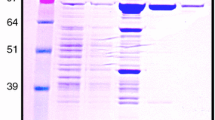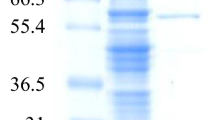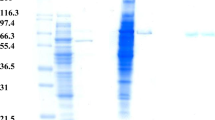Abstract
β-Galactosidase was isolated from the cell-free extracts ofLactobacillus crispatus strain ATCC 33820 and the effects of temperature, pH, sugars and monovalent and divalent cations on the activity of the enzyme were examined.L. crispatus produced the maximum amount of enzyme when grown in MRS medium containing galactose (as carbon source) at 37°C and pH 6.5 for 2 d, addition of glucose repressing enzyme production. Addition of lactose to the growth medium containing galactose inhibited the enzyme synthesis. The enzyme was active between 20 and 60°C and in the pH range of 4–9. However, the optimum enzyme activity was at 45°C and pH 6.5. The enzyme was stable up to 45°C when incubated at various temperatures for 15 min at pH 6.5. When the enzyme was exposed to various pH values at 45°C for 1 h, it retained the original activity over the pH range of 6.0–7.0. Presence of divalent cations, such as Fe2+ and Mn2+, in the reaction mixture increased enzyme activity, whereas Zn2+ was inhibitory. TheK m was 1.16 mmol/L for 2-nitrophenyl-β-d-galactopyranose and 14.2 mmol/L for lactose.
Similar content being viewed by others
References
Beckwith J.: The lactose operon, pp. 1444–1452 in J.L. Ingraham, K.B. Low, B. Magasanik, M. Schaechter, H.E. Umbarger (Eds):Escherichia coli and Salmonella typhimurium: Cellular and Molecular Biology. American Society for Microbiology, Washington (DC) 1987.
Blankenship L.C., Wells P.A.: Microbial β-galactosidase: a survey for neutral pH optimum enzymes.J. Milk Food Technol.37, 199–202 (1994).
Fisher K., Johnson M.C., Ray B.: Lactose hydrolyzing enzyme inLactobacillus acidophilus strains.Food Microbiol.2, 23–29 (1985).
Gekas V., López-Leiva M.: Hydrolysis of lactose: a literature review.Process Biochem.20, 2–12 (1985).
Goodman R.E., Pederson D.M.: β-Galactosidase fromBacillus stearothermophilus.Can. J. Microbiol.22, 817–825 (1976).
Greenberg N.A., Mahoney R.R.: Immobilisation of lactase (β-galactosidase) for use in dairy processing: a review.Process Biochem.16, 2–8 (1981).
Greenberg N.A., Mahoney R.R.: Production and characterization of β-galactosidase fromStreptococcus thermophilus J. Food Sci.47, 1824–1835 (1982).
Harju M.: Lactose hydrolysis.Internat. Dairy Food Bull.212, 50–55 (1987).
Hickey M.W., Hillier A.J., Jago G.R.: Transport and metabolism of lactose, glucose, and galactose in homofermentative lactobacilli.Appl. Environ. Microbiol.51, 825–831 (1986).
Iwasaki T., Yoshioka Y., Kanachi T.: Study on the metabolism ofLactobacillus bifidus. III. Purification and some properties of β-galactosidase of a strain ofLactobacillus bifidus.Nippon Nogei Kagaku Kaishi45, 207–215 (1971).
Kandler O., Weiss N.: GenusLactobacillus, pp. 1209–1234 in P.H.A. Sneath, N.S. Mair, M.E. Sharpe, J.G. Holt (Eds):Bergey's Manual of Systematic Bacteriology, Vol. 2, Williams and Wilkins, Baltimore 1986.
Kang Y., Kim J.H., Ryu D.D.Y.: Protoplast fusion ofLactobacillus casei.Agric. Biol. Chem.51, 2221–2227 (1987).
Lineweaver H., Burk D.: Determination of enzyme dissociation constants.J. Am. Chem. Soc.56, 658–666 (1934).
Linko S., Enwald S., Vahvaselkä M., Mäyrä-Mäkinen A.: Optimization of the production of β-galactosidase by an autolytic strain ofStreptococcus salivarius subsp.thermophilus, pp. 588–594 in A. Tanaka, H.W. Blanch (Eds).Enzyme Engineerings XI. The New York Academy of Sciences, New York 1992.
Magasanik B., Neidhardt F.C.: Regulation of carbon and nitrogen utilization, pp. 1318–1325 in J.L. Ingraham, K.B. Low, B. Magasanik, M. Schaechter, H.E. Umbarger (Eds):Escherichia coli and Salmonella typhimurium: Cellular and Molecular Biology. American Society for Microbiology, Washington (DC) 1987.
Monod J., Cohn M.: La biosynthése induite des enzymes (adaptation enzymatique).Adv. Enzymol.13, 67–119 (1952).
Poolman B.: Biochemistry and molecular biology of galactoside transport and metabolism in lactic acid bacteria.Lait73, 87–96 (1993).
Poolman B., Royer T.J., Mainzer S.E., Schmidt B.F.: Carbohydrate utilization inStreptococcus thermophilus: characterization of the genes for aldose I-epimerase (mutarotase) and UDP-glucose 4-epimerase.J. Bacteriol.172, 4037–4047 (1990).
Premi L., Sandine W.E., Elliker P.R.: Lactose-hydrolyzing enzymes ofLactobacillus species.Appl. Microbiol.24, 51–57 (1972).
Rahm K.A.A., Lee B.H.: Production and characterization of β-galactosidase from psychrotropicbacillus subtilis KL88.Biotechnol. Appl. Biochem.13, 246–256 (1991).
Ramana Rao M.V., Dutta S.M.: An active β-galactosidase preparation fromStreptococcus thermophilus.Indian J. Dairy Sci.32, 187–188 (1979).
Ramana Rao M.V., Dutta S.M.: Purification and properties of β-galactosidase fromStreptococcus thermophilus.J. Food. Sci.46, 1419–1423 (1981).
Riou C., Freyssinet G., FVvre M.: Purification and characterization of a β-galactosidase fromStreptococcus thermophilus.J. Food Sci.46, 1419–1423 (1981).
Saito T., Kato K., Maeda S., Suzuki T., Shiba S., Lijima S., Kobayashi T.: Overproduction of thermostable β-galactosidase inEscherichia coli, its purification and molecular structure.J. Ferment. Bioeng.74, 12–16 (1992).
Sani R.K., Chakraborti S., Sobti R.C., Patnaik P.R., Banerjee U.C.: Characterization and some reaction-engineering aspects of thermostable extracellular β-galactosidase from a newBacillus species.Folia Microbiol.43, 367–371 (1999).
Sasaki K., Samant S.K., Suzuki M., Toba T., Itoh T.: β-Galactosidase and 6-phospho-β-galactosidase activities in strains of theLactobacillus acidophilus complex.Lett. Appl. Microbiol.16, 97–100 (1993).
Smart J.B., Crow V.L., Thomas T.D.: Lactose hydrolysis in milk and whey with β-galactosidase fromStreptococcus thermophilus.N. Z. J. Dairy Sci. Technol.20, 43–56 (1985).
Smith P.K., Krohn R.I., Hermanson G.T., Mallia A.K., Gartner F.H., Provenzano M.D., Fujimoto E.K., Goeke N.M., Olson B.J., Klenk D.C.: Measurement of protein using bicinchoninic acid.Anal. Biochem.150, 76–85 (1985).
Toba T., Tomita Y., Itoh T., Adachi S.: β-Galactosidase of lactic acid bacteria: characterization by oligosaccharides formed during hydrolysis of lactose.J. Dairy Sci.64, 185–192 (1981).
Wierzbicki L.E., Kosikowski F.V.: Lactase potential of various microorganisms grown in whey.J. Dairy Sci.56, 26–32 (1973).
Author information
Authors and Affiliations
Rights and permissions
About this article
Cite this article
Kim, J.W., Rajagopal, S.N. Isolation and characterization of β-galactosidase fromLactobacillus crispatus . Folia Microbiol 45, 29–34 (2000). https://doi.org/10.1007/BF02817446
Received:
Issue Date:
DOI: https://doi.org/10.1007/BF02817446




